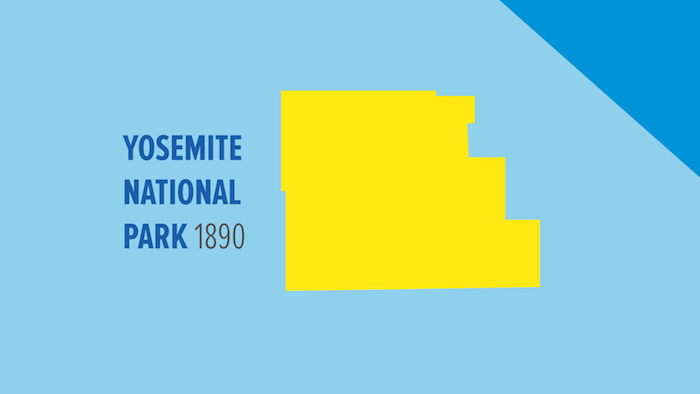
Yosemite National Park landscape today (in yellow)/Conservation International
During a 32-year-period early in the 20th century, roughly one-third of Yosemite National Park in California was removed from the park so the land could be opened to natural resource extraction, according to an analysis published in Ecology and Society.
The researchers note that when the national park was established in 1890, Yosemite covered an area of 1,500 square miles. During the next several decades, though, Yosemite’s boundaries shifted seven times: five small parcels were added and two large tracts of land were removed. "Overall, Yosemite’s size was reduced by 29.8%. (505.5 square miles). Today, the forests that were removed from the park are more highly fragmented by roads than forests which remain protected."
The authors -- a team of scientists from Conservation International, George Mason University and Clark University -- believe, however, that these losses are reversible, as certain parcels that were removed were later protected as wilderness areas that could be reunited with Yosemite and offer more contiguous habitat.
“Over a century ago, Yosemite was set aside to be protected in perpetuity. Since then, protection has been maintained for some of it but not for all,” said Rachel Golden Kroner, a PhD candidate at George Mason University and lead author of the study. “The 100th anniversary of the National Park Service provides an opportunity to reflect on ‘America’s Best Idea.’ Recognizing the impermanence of national parks and other protected areas reminds us that we should not take these national treasures for granted.”
The authors and their colleagues have documented what they refer to as "protected area downgrading, downsizing and degazettement," or PADDD, across the globe. Mike Mascia, study co-author and senior director of social science at CI’s Moore Center for Science, first coined the term “PADDD” and has been working with colleagues around the world to document this largely overlooked phenomenon since 2009. Their work is captured on PADDDtracker.org, a crowd-sourced website that Mascia and colleagues launched to both document and disseminate information about PADDD.

Yosemite National Park's landscape in 1890/Conservation International
The researchers note that while United States national parks are widely perceived as sacrosanct, "legal changes to Yosemite’s boundaries demonstrate that the USA is not immune to PADDD." For instance, they point to Saguaro and Big Bend national parks, where there have been calls by some politicians to remove legal and regulatory obstacles to allow for infrastructure construction for border security purposes.
And in Brazil, they note, Iguaçu National Park and Dunas de Natal State Park were recently proposed to be PADDDed to allow highway construction, Emílio Einsfeld Filho Private Natural Heritage Reserve was recently proposed to be downsized to allow dam construction, and Amapá State Forest was recently proposed to be degazetted to allow industrial agriculture.
“As we look ahead to the future of national parks in the USA and around the world, the history of Yosemite demonstrates the critical importance of protection and the lasting legacy of when protection is lost,” said Mascia. “Environmental policies must account for the fact that we not only can create national parks, but we can also take them away—and when we do take away protection, there can be lasting consequences.”
Mascia said that if appropriate policies are not in place, PADDD could happen under the radar, resulting in the loss of natural heritage and the services protected areas provide for climate and other ecosystem services. Though it has been widely documented, the rate of PADDD remains unclear, as do the impacts on biodiversity and ecosystem services.



Comments
"Nothing dollarable is safe, however guarded." Should have a correalary - "but better guarded than not".
I've heard apologists hedge that "resource extraction does not necessarily ruin the land", but it nearly always does, and it will be a fear for the next four years.
No matter if you pop the balloon or if you slowly let the air out, you end up with an empty balloon.